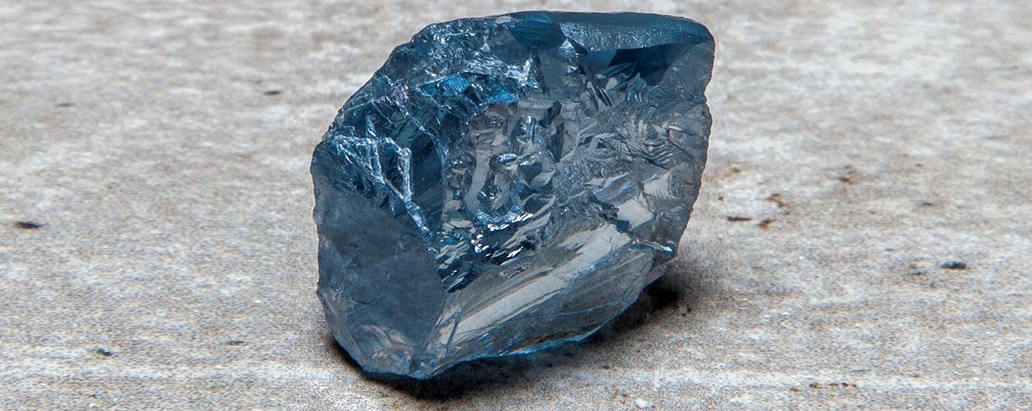Does your partner absolutely adore diamonds AND the color blue? If so, we have good news! The world’s largest blue diamond is going to be auctioned next month, and we’re here to tell you more about it. You probably can’t afford this $48 million beauty, but you might get some ring inspiration, especially if wedding bells are in your future. Learn more about the De Beers Cullinan Blue!
History of the De Beers Cullinan Blue Diamond
Let’s take you back to where it all began. This special diamond was discovered in April 2021 in South Africa’s Cullinan mine. In its natural form, the rough, blue stone weighed almost 40 carats and was purchased for a whopping $40 million by De Beers Group and Diacore, companies that specialize in diamond manufacturing and retail. Within the past year, they worked to transform the diamond into a 15.10-carat, polished, blue gem that features step cuts, meaning the diamond’s flat surfaces are arranged like steps.
Described as “powerful … calm and majestic” by jewelry broker Sotheby’s, the De Beers Cullinan Blue is not only the largest vivid blue diamond that’s on its way to auction, but it will also be on display in international cities later this year, including London, Shanghai and Singapore. The highest bidder will even receive a “unique crown ring,” which De Beers specifically crafted for the stone.

Image courtesy of De Beers Group
Why is the De Beers Cullinan Blue Special?
So, why is all of this such a big deal? Blue diamonds are quite rare. They’re actually the rarest colored diamonds, except for red diamonds. In the auction world, only five blue diamonds weighing between 10 and 15 carats have ever been sold. For reference, Sotheby’s has auctioned plenty more art pieces by famous painters Pablo Picasso and Claude Monet in the past two decades! In fact, the Gemological Institute of America (GIA), which grades diamonds, has never evaluated a vivid blue, step-cut diamond that’s as large and internally flawless as the De Beers Cullinan Blue!
Just like white diamonds, blue versions are judged based on their cut, color, clarity and carat weight (aka the 4 C’s), with color being the most important quality. For gem cutters, it’s a challenge to produce blue diamonds, as a slight error could result in a less colorful stone.
Despite these difficulties, GIA gave the De Beers Cullinan Blue a “Fancy Vivid Blue” rating – the highest possible ranking on the grading scale for blue diamonds. A mere 1% of GIA-evaluated blue diamonds have achieved that level. But it’s even rarer for a step-cut diamond to earn such a ranking. That’s because most other fancy-cut diamonds tend to display more intense color when viewed from above.
It’s also pretty remarkable that a gem with such large, flat surfaces could be so flawless. In terms of clarity, GIA classified the De Beers Cullinan Blue among other Type IIb diamonds, which make up less than 0.5% of all diamonds.
With such stellar ratings, how much will this valuable piece actually sell for? This might give you an idea. The Oppenheimer Blue – a similar vivid blue, step-cut diamond that weighs 14.62 carats – was purchased for $57.5 million in 2016, and it still holds the auction record for most expensive blue diamond. All we can say is the De Beers Cullinan Blue is larger, internally flawless and has a deeper blue shade!
What is a Blue Diamond?
Although they can look very similar to sapphires, blue diamonds are completely different gemstones. They’re simply natural diamonds with a blue tint. That means they were formed billions of years ago beneath the Earth’s surface and are primarily made of carbon.
You’ll see blue diamonds in a range of shades, from light to deep blue. Some stones even feature a secondary color, such as violet, green or gray. While other gems undergo heat treatments to enhance their hue, blue diamonds get their color from the element boron that’s sometimes present in a diamond’s structure.
In addition to the Cullinan mine in South Africa, which produces some of the most famous diamonds (ex. the Great Star of Africa), two other locations were recent sources of blue diamonds: a mine in the Golconda region of India and the Argyle Diamond Mine in Australia. In fact, the Golconda region is reportedly the site of the first documented blue diamond. During the 17th century, French explorer and merchant Jean-Baptiste Tavernier bought a 112-carat blue diamond in the area and later sold it to King Louis XIV of France. Many years later, it became known as the Hope Diamond, and it’s still on display at the Smithsonian Institution in Washington, D.C.
If you’re hoping to get your hands on a blue diamond, keep in mind that larger stones and those with deeper, pure hues are rarer and more expensive. So, you’re more likely to find gems weighing less than 0.3 carats than 2-carat gems. If you’re not sure whether a stone is a blue sapphire or diamond, it’s best to check with a certified gemologist.
Have a question? We can help!
Gage Diamonds is Chicago's premier jewelry showroom and online retailer of engagement rings, wedding bands, and fine jewelry. We offer a selection of dazzling handpicked diamonds, including certified natural diamonds.
We’re committed to helping you find the ring of your dreams. For inspiration, browse our website or set up an appointment with a member of our trusted staff at our in-person showroom.
We offer no-credit-needed financing – feel free to apply and get your approval within 24 hours!
Pay over time, because love shouldn’t wait.
Image courtesy of De Beers Group

